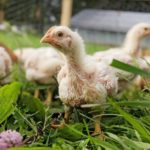Pastured Poultry Fact Sheet
Click here to download a printable version of this fact sheet.
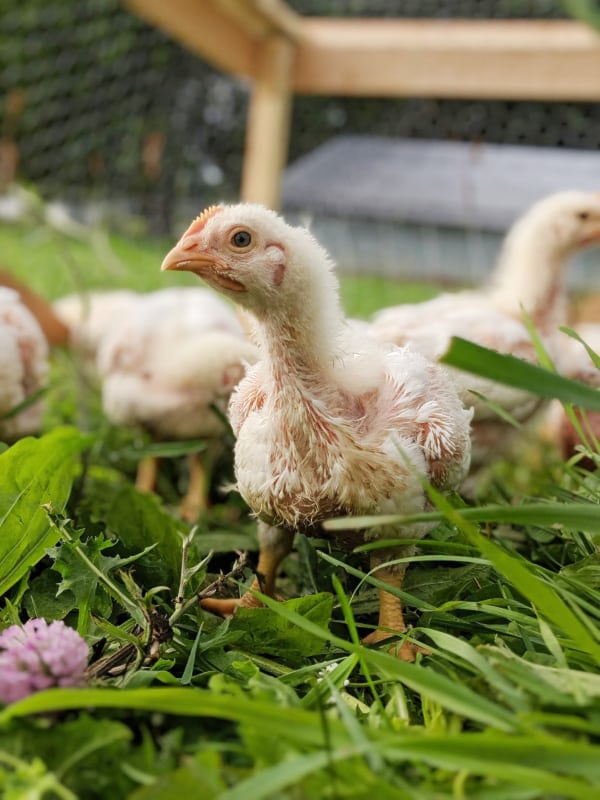
Why Pastured Poultry?
- Poultry raised on pasture offers a much better quality of life for both the birds and the farmer. The poultry can glean up to 20 percent (turkeys 30 percent) of its diet from a healthy pasture while directly depositing their manure back onto the landscape, cutting feed costs and eliminating having to haul and spread bedding.
- Pasture-raised poultry meat has been proven to have a much healthier nutritional profile than conventionally raised meat.
- Raising poultry offers a much better working environment for the farmer in the form of fresh air, lower mortality, better profit, seasonal production, and producing a higher-quality product in a system that improves air, water and soil. Pastured poultry also can often be stacked alongside other farm enterprises.
- Poultry manure is high in nitrogen and phosphorus. Pastures, after poultry have grazed on them, are dark green and have a rich nutrient profile for other livestock to graze.
Pastured Poultry Facts
- A chicken raised for meat is called a broiler, while a chicken raised for egg production is typically called a layer.
- A broiler takes about 6-8 weeks from hatching to slaughter; though some growers achieve a marketable bird in 6-7 weeks with the right feed and management. Heritage breeds, or slower-growing broilers, will take 10-12 weeks.
- A turkey takes 16 weeks from start to finish; heritage breeds take slightly longer.
- A Cornish rock broiler takes three pounds of feed for every pound of finished weight. Fifteen pounds of feed will get a broiler to about five pounds finished weight.
- A laying chicken will need about five months from hatching until she lays her first egg. After that, she has about a two-year production life, depending on the breed.
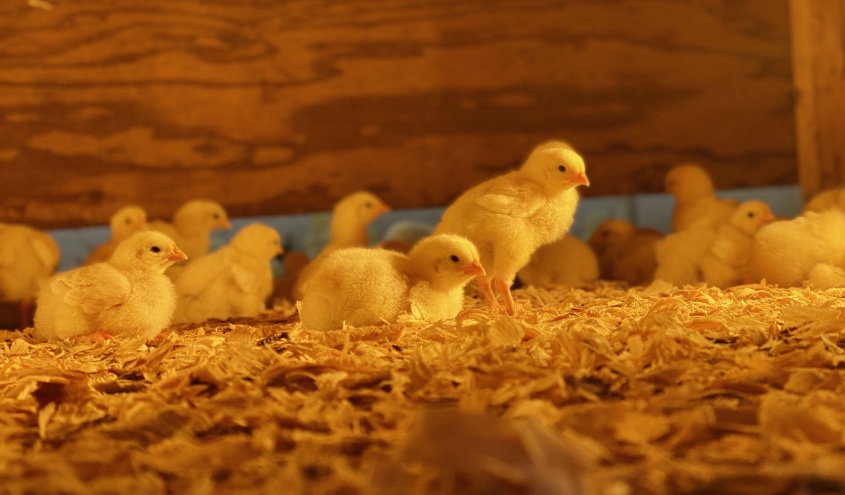
Brooding
- Young poultry need a warm, draft-free environment to start their lives. This place is called a “brooder” and is equipped with a heat source, feed, and water for the young birds as well as a way to ventilate the brooder should it get too warm. Most broiler chicks spend 2-3 weeks (depending on outside conditions) in a brooder before they transition to pasture.
- Calculate a half square foot of room per chick or turkey poult. If you believe that the birds will stay in the brooder past 3 weeks of age, you will want to increase that number.
- Turkey poults are very fragile for the first 4-5 weeks of life. For this reason, they should be brooded separately from other poultry and given very high levels of care. Higher-protein feed (26-28 percent) is normally used for starting turkeys.
- When startled or scared, baby chicks and poults can “pile” into corners and suffocate each other. For that reason, it is always good to keep the brooder environment free of loud noises, pets, and other possible distractions. To cut down on the piling possibility, you can start your chicks in round or oval brooders or try to round out the 90-degree corners in your brooder by using cardboard.
- Start your young chicks or poults in a brooder at 95 degrees. You can plan to lower that temperature by five degrees every week until they are fully feathered. Observing by watching and listening is key; monitor your chicks and observe their behavior. Chicks huddled under or close to the heat source are too cold. On the contrary, chicks that are trying to get as far away as possible from the heat source are too hot. You want to see the chicks spread out across the brooder engaged in eating, drinking, and resting. Noise level of the chicks is also important. Contented chicks don’t cheep loudly; your brooder should be fairly quiet when the chicks are happy.
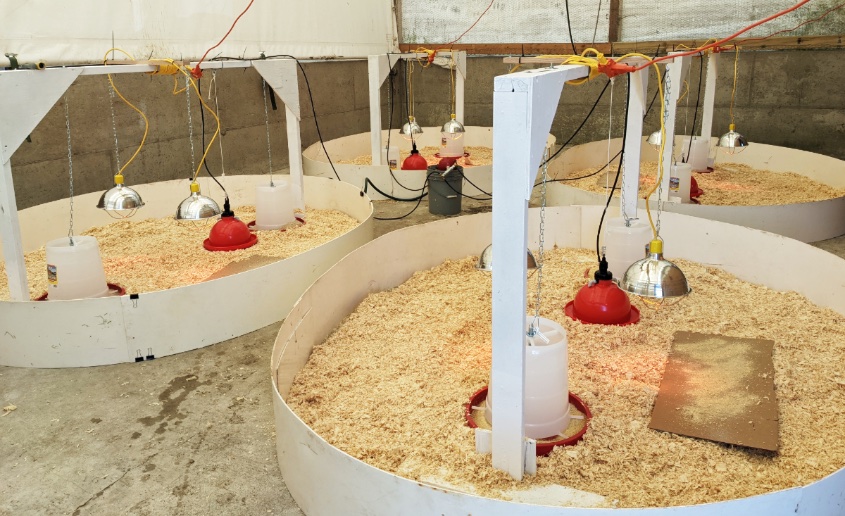
Chicks in a brooder at Grassfed Cattle Company, Goodhue, Minn. Photo by Valerie Luhman.
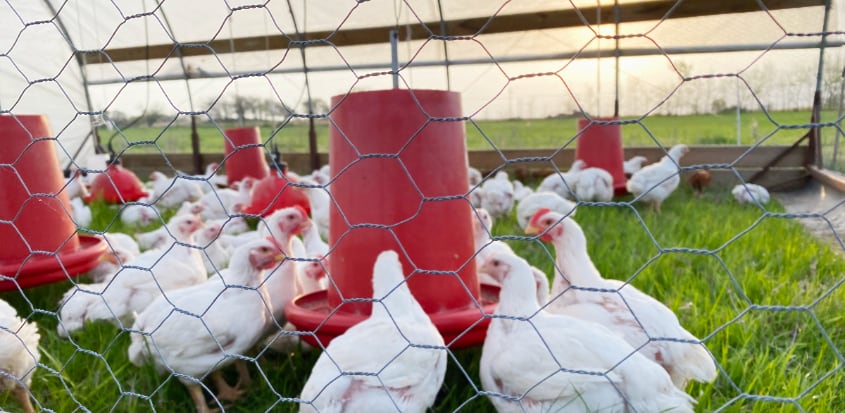
Closeup of broilers in a mobile range coop. Photo by Jonathan Kilpatrick.
Raising on Pasture
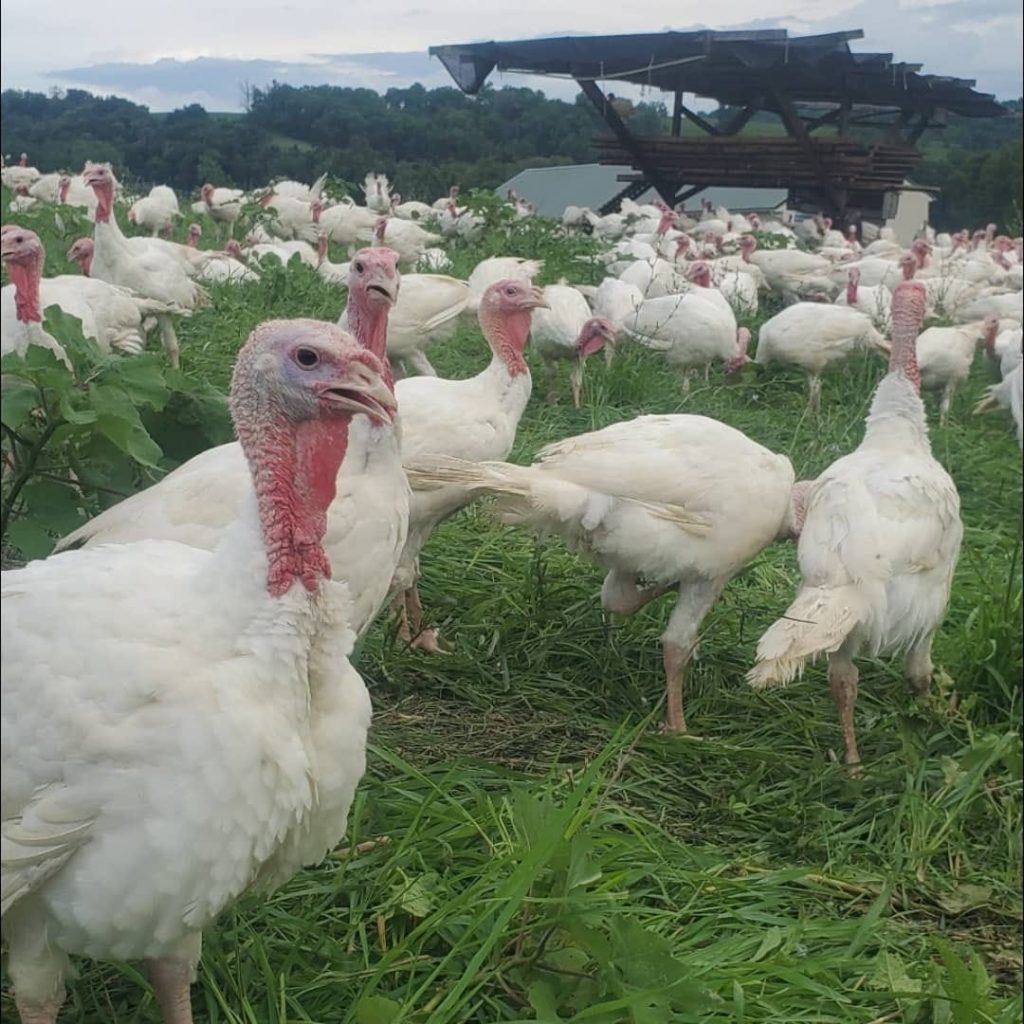
- Once transitioned to pasture, moving your shelters daily is best for optimum pasture recovery and bird performance. When broilers get to be 6+ weeks old, moving two or more times a day can help avoid applying too much manure (high in nitrogen) to the pasture and will speed pasture recovery. If using an electrified poultry net with a shelter for layers or turkeys, moves every other day or every third day are best.
- For broilers in a field shelter or mobile-range coop without additional electrified netting, allow 1.5 sq.ft/bird. Because of their sedentary nature, most broilers do best in just a shelter or MRC moved once a day. Heritage-breed broilers or Freedom Rangers (a slower growing French breed of broiler) can do quite well in an open-range setting.
- On the other hand, turkeys will forage quite aggressively and can actually glean up to 30 percent of their diet from forage alone. For this reason, turkeys do very well past 7 weeks in electrified poultry netting moved every other day. A roosting trailer/simple shelter so they can get out of the rain and sun is all that is really needed past that 7-8 week age. This pertains to late spring, summer, and early fall. Late fall/winter production is not advised due to decreasing weight gains and higher maintenance requirements.
- In the warmer months, layers can be managed similarly to turkeys, except that they will need nest boxes added to the shelter. Plan for .5 square feet of shelter space for layers. In the winter months, layers can be managed quite well on deep bedding. Allow five square feet of space per bird so that the bedding doesn’t get capped (a thick coating of manure that makes it difficult for the chickens to stir the bedding). Some farmers use hoop-house structures in the winter months, and on sunny days the layers will be quite comfortable in that setting. Combined with deep, composting bedding (provides heat to the house) the layers can overwinter quite comfortably.
- Poultry are omnivores, so a purely forage-based diet is not sufficient. They will glean a lot from the pasture, and if rotated frequently enough and given quality pasture with a lot of diversity, can glean plenty of insects, seeds, and grasses to supplement their diet. Poultry forage the best when there are plenty of legumes and forbs available in the pasture. The smaller, rounder leaves are easier for them to eat compared with longer, slender grass leaves. If planting a pasture for poultry, try adding in lots of broadleaf forbs, such as plantain, chicory, or safflower. Clovers, alfalfa, and various vetches work well for legumes and are easy for poultry to graze on. Diversity is the key for healthy soil and livestock, and keep in mind what other livestock species you may be able to graze either before or after the poultry when planning your planting.
- There are many different options for chicken feed, with the most commonly used ingredients being corn, soy, and wheat. However, peanut meal, milo, flax, oats, and some other combinations are successfully used by folks who have a market demand for corn and soy-free products or are in an area where these ingredients are easy to source. To minimize feed waste, try to keep the lip of the feeder at the bird’s back height. This will also force broilers to stand and eat, which promotes healthy leg development. By using easy-to-adjust rope or chain to hang your feeders, you can easily raise and lower feeders to match the stage of bird growth.
Shelter Options
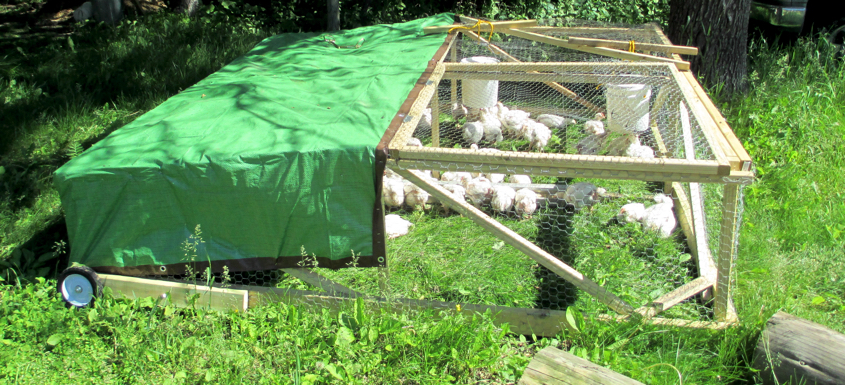
Chicken tractor or ‘Salatin Pen’ at North Circle Seeds, Vergas, Minn. Photo by Zachary Paige.
Field Shelters
Field shelters (sometimes called chicken tractors) are typically smaller shelters that are easily moved by hand, sometimes with the aid of a dolly or wheels installed on the shelter. The most common size, 10’x12’x2’, was made popular by Joel Salatin, and has been referred to as the “Salatin pen.” Many other shelter designs have been spun off this size. It allows for about 75 broilers per shelter, and is about the largest size that is still easy enough to move by hand with the aid of a dolly. An advantage of this size of shelter is that with two people, it is easy to transport from field to field or even farm to farm. They can be stacked on a flat-bed trailer, making your operation easily portable – a great advantage when your land is rented or leased. Another advantage is the low cost of building this type of infrastructure. A disadvantage is that there is generally a higher level of labor and time that goes into raising birds in these shelters.
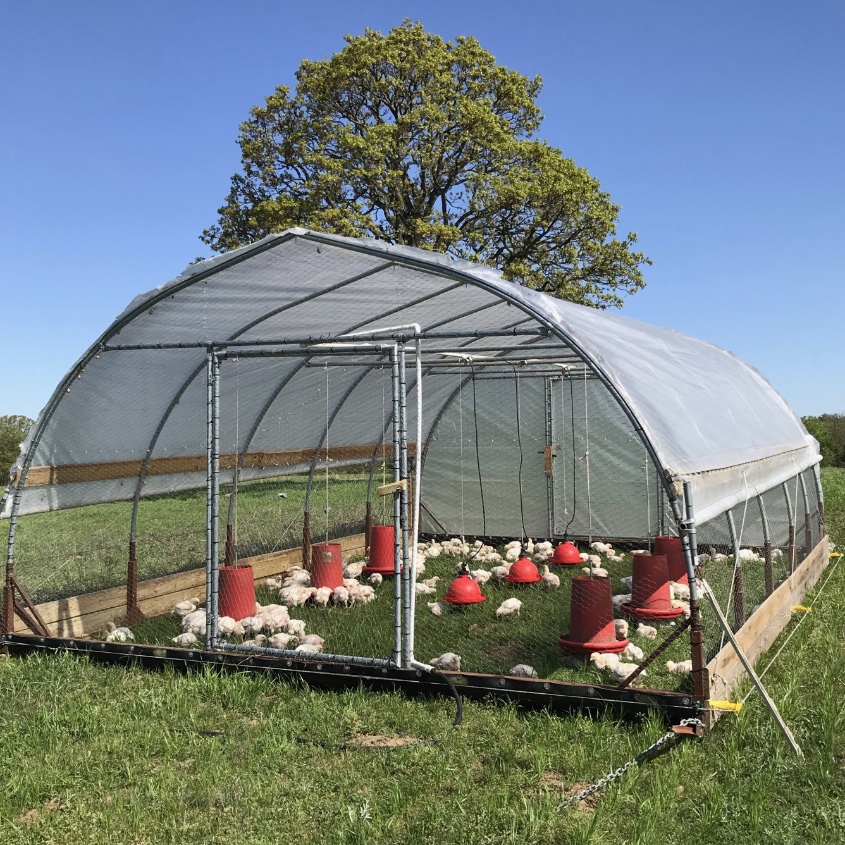
Mobile Range Coop. Photo by Jonathan Kilpatrick.
Mobile Range Coops
This style of shelter is geared towards the serious producer on a commercial scale. Coops on the smaller end are 15’x20’ and hold about 200 broilers and on the larger side are about 20’x48’ with a capacity of 600 or more broilers. Coops of this style can be constructed by yourself, or there are several options in the resource section where you can order a kit. These coops are too big and heavy to be moved by hand and will require a side by side, tractor, or truck to move. An advantage of this style coop is that it is very much a multiple-use structure. With a couple easy modifications, it can be handily used for wintering other livestock species such as pigs or small ruminants. It also could be used for season extension in a vegetable operation. The use of clear greenhouse plastic may potentially allow for a couple weeks of field season extension in your poultry operation. If using clear greenhouse plastic, make sure that you have shade cloth available for use during the hotter summer months. Another advantage is the ability to move a larger amount of birds in less time, thus making them highly efficient.
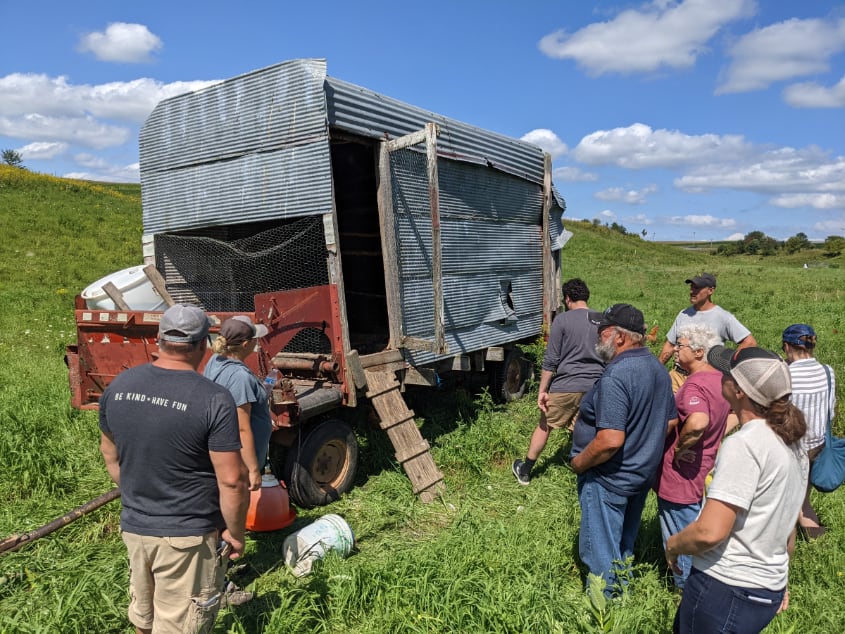
Eggmobile at Wholesome Family Farms, Caledonia, Minn. Photo by Katie Feterl.
Eggmobiles
As the name implies, this model of shelter is designed with the egg-laying flock in mind. Built to be highly portable, most of these houses are stationed on wheels vs. a skid-type shelter, which allows the structure to be moved long distances with ease. Building on wheels requires that the floor level of the house be higher off the ground, which is difficult for broilers to climb, so most wheeled type coops are used for laying hens. These structures typically contain nest boxes, roosts, feed (under cover so it doesn’t get wet) and a water source for the birds. The birds are either free range (think about predator concerns) or are contained in an electrified poultry netting. This model was popularized by Joel Salatin as a model for egg production using laying chickens to follow cow herds and clean and sanitize the pastures and consume fly larvae from cow manure. Done properly, this method can have a tremendous impact on fly populations in cattle herds. This model is a good example of how pastured poultry can be another enterprise stacked on the same land base as another enterprise.
Resources
Infrastructure:
- The Mobile Chicken House – Fully-equipped chicken coops designed for high-efficiency commercial scale production models in pasture-based systems.
- PastureTek – Another great shelter option for the commercial-scale producer.
- Poly-tex – A Minnesota-based distributor for mobile range coops.
- Hen Gear – Focuses on providing quality equipment for egg layer operations.
- Premier 1 Supplies – Distributors of the best quality portable electric chicken netting. Also carry a variety of supplies for small-scale operations.
Watering Equipment
- Plasson Broiler Drinker – One of the best options for adult birds, both broilers and layers. Can be used in both pressurized water systems or connected to a five-gallon bucket and gravity fed. Not for winter use.
- Nipple Watering System — Nipple waterers are great for use in brooders and offer an alternative to drinkers. Farmtek also offers various shelter arrangements and feeders.
Feeders
- Brower – Lots of chicken feeder options.
- Kuhl Hanging Feeder – Excellent feeder for mobile range coops with large numbers of birds.
- Good option for smaller “Salatin style shelters”
Hatcheries
- Strombergs (Minnesota)
- Dahline Poultry (Minnesota)
- Welps Hatchery (Iowa)
- Murray McMurray (Iowa)
Feed Mills (all Minnesota mills)
Information
- The American Pastured Poultry Producers Association is a membership-based organization that provides education, collaboration, and networking opportunities for pastured poultry farmers.
- The Small Scale Poultry Flock by Harvey Ussery.
- Pastured Poultry Profits by Joel Salatin. A timeless classic on poultry production from the original innovator and leader of pastured poultry production.
- Chelsea Green article on small-scale poultry.
- Robert Plamondon – A great compilation of helpful tips and tricks, plus brooder and shelter designs for small-scale growers.
- pasturedpoultryinfo.com – A great compendium of information.

